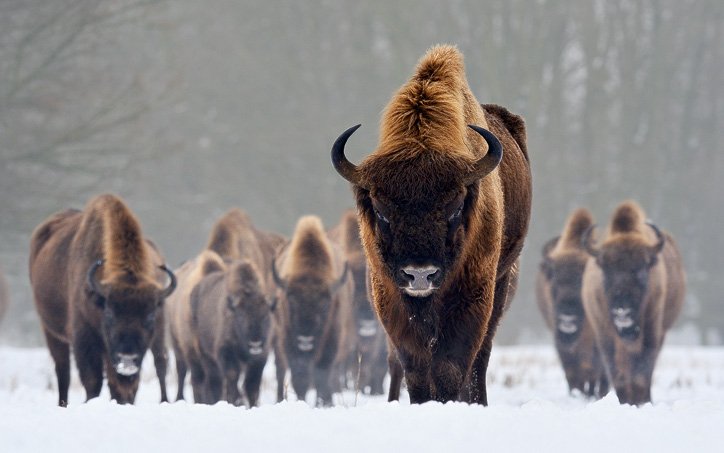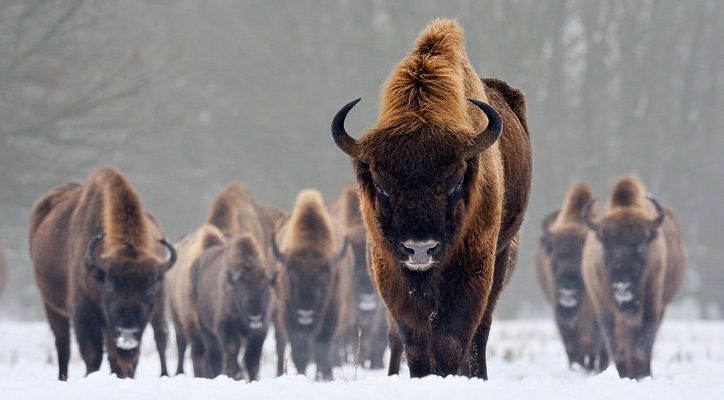
The European bison can be seen as a keystone species, meaning its presence has a disproportionately large impact on its environment compared to its size. Imagine a tiny key that unlocks a big door; without that key, the door simply won’t open. By grazing on grass and shrubs, these bison help to shape the landscape, which in turn supports a variety of other species. So, what exactly do these bison do to help their environment, and why should we care? Let’s dig deeper.
Grazing and Landscape Management
European bison are large herbivores, which means they love munching on grasses, leaves, and shoots. When they graze, they don’t just fill their bellies—they’re actively managing the landscape around them. By consuming certain plants, they allow others to thrive. This act of selective grazing promotes biodiversity, creating a more balanced and healthy ecosystem.
Here’s the thing: when bison graze, they often knock down shrubs and thick undergrowth, making way for sun-loving plants. This benefits not only the plants they prefer but also those that might struggle to get enough sunlight. You might be wondering how this affects the whole ecosystem. Well, more plant diversity leads to a richer habitat for a variety of insects, birds, and even small mammals.
Furthermore, bison contribute to soil health. Their grazing habits help aerate the soil, allowing rainwater to soak in more effectively. This is vital for maintaining water levels in the ecosystem, especially in drier months. Healthy soil means healthy plants, which translates to a thriving habitat for countless creatures.
Creating Habitats for Other Species
When European bison roam through their habitats, they don’t just consume; they also create spaces for other animals. Their large, heavy bodies trample the ground, which can lead to the formation of wallows—shallow depressions filled with water. These wallows become perfect little watering holes for various animals, especially in hot weather.
Moreover, the areas that bison graze on often turn into rich habitats for birds and insects. For instance, certain bird species love to nest in the thick grass that flourishes where bison have grazed. You could think of these bison as the ultimate landscape architects, shaping their environment in ways that benefit other wildlife.
These wallows and grazed areas also collect seeds and plant materials, providing food and shelter for different species. In a way, the European bison acts like a gardener, cultivating a diverse array of plants and providing homes for other animals.
The Impact on Plant Diversity
With the European bison grazing, they not only control which plants thrive, but they also encourage a diverse plant community. This is key to a healthy ecosystem. More plant species mean better resources for herbivores and, in turn, predators. Imagine a buffet where everyone can find something they enjoy. A diverse plant community ensures that herbivores can eat well, which helps maintain the entire food web.
Research has shown that areas with bison present tend to have a higher variety of plant species compared to areas without them. In fact, some plants thrive specifically because of the grazing patterns of bison. They regularly cycle through areas, giving plants time to recover and grow, which is essential for long-term ecosystem health.
Moreover, diverse plants attract various pollinators, like bees and butterflies, which are crucial for reproduction and biodiversity. So, in supporting bison, we’re also nurturing the very fabric of life around them. It’s a delicate dance, but one that’s vital for the survival of numerous species.
The Role in Seed Dispersal
European bison are not just consumers; they’re also great at seed dispersal. As they munch on plants, they often ingest seeds that pass through their digestive systems. When they move around, they deposit these seeds in new locations, giving them a chance to grow where they otherwise might not have. It’s a natural form of gardening!
This method of seed dispersal is particularly important for maintaining genetic diversity among plants. By spreading seeds over greater distances, bison help plants colonize new areas, allowing ecosystems to adapt to changes over time. This can be especially beneficial in response to environmental shifts, like climate change.
So, the next time you think about the European bison, remember that they’re not just big, gentle giants. They’re also nature’s little helpers, ensuring that life continues to thrive in their environment.
Conservation and the Future of the European Bison
Despite their critical role in ecosystems, European bison faced severe population declines due to hunting and habitat loss. Conservation efforts have become essential in recent years to help these magnificent creatures bounce back. With dedicated programs focused on habitat restoration and breeding, the European bison is slowly making a remarkable recovery.
These efforts aren’t just about saving a species; they’re about preserving the entire ecosystem that relies on them. With more bison in the wild, the balance of their habitats is restored, which positively affects many other plants and animals.
Conservationists emphasize the interconnectedness of life. Every creature has its part to play in maintaining the tapestry of existence—bison included. As we work to protect European bison, we also protect countless other species that depend on a healthy ecosystem.
Why Should We Care?
You might still be wondering, “Why does this all matter to me?” Well, the health of ecosystems affects us all. The plants and wildlife that thrive because of European bison play vital roles in supporting clean air, water, and even food. Healthy ecosystems provide us with resources, recreational opportunities, and a sense of connection to nature.
Moreover, understanding the role of European bison in their ecosystems teaches us about the balance of life. It reminds us that every species, no matter how big or small, contributes to the world around us. By appreciating these connections, we become more motivated to protect our environment.
In the end, the European bison is more than just an animal; it’s a symbol of resilience and the beauty of interconnectedness in nature. So, when you think of these magnificent creatures, remember the crucial roles they play—not just for themselves, but for the entire ecosystem.
By learning about and supporting the European bison, we can help ensure that their ecosystems thrive for generations to come. It’s a journey worth embarking on together, isn’t it?

